Why induction heating is the most innovative option for food processing industry
Induction Drying Processing
Drying consists of providing heat to accelerate evaporation of volatile organic compounds present in an item. For example the ones present in water, solvents in paints, etc.
Drying is a process used in the manufacture of a wide range of products. The fields where we can apply induction are those that require direct or indirect heating through a metallic element.
Examples:
- Direct: automotive disc brakes
- Indirect: drying of paper
There are several methods to achieve the drying process, such as microwave, infrared and electrical resistance. However induction offers a number of advantages over these methods.
 Induction heating is an innovative and non-contact electromagnetic heating technology that has several advantages such as high energy efficiency, controlled heating, high safety, and pollution-free. The objective of this article is to build up these and other advantages based on different scientific data about the performance of induction heating in the food industry. We believe that the companies that will apply induction heating in their procedures will have more versatility in sustainable food methods and will be able to face future challenges.
Induction heating is an innovative and non-contact electromagnetic heating technology that has several advantages such as high energy efficiency, controlled heating, high safety, and pollution-free. The objective of this article is to build up these and other advantages based on different scientific data about the performance of induction heating in the food industry. We believe that the companies that will apply induction heating in their procedures will have more versatility in sustainable food methods and will be able to face future challenges.
About Induction heating
The induction heating system (generator + coil) will generate a magnetic field that induces a current in the conductive material (reactor vessel), which will rise in temperature. Induction heating works only with conductive and ferrous materials. Depending on the
material’s magnetic permeability and ferromagnetic properties, various metallic materials, such as steel, cast iron, among others, could be heated by induction. Non-magnetic conductive materials can also be heated with a lower efficiency. Induction heating is seen as an
ideal technology for pasteurizing liquid foods
, but the
versatility of induction electric heaters makes it possible to use in
various fields of food and beverage industry as is shown in the next image:
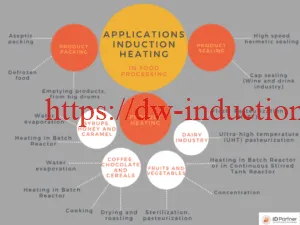
Induction heating has its advantages over the conventional heating systems (resistance, hot water, gas, steam, etc.) Since it is
non-contact it is very
efficient, and the heat is generated inside the work-piece (sample) this means
direct heating of metal surface without thermal inertia and
no conduction loss. And since induction requires no warm-up or cool-down cycle
, make it highly compatible with energy-efficient automated systems. Read the complete article to find out the
5 most important facts about Induction Heating in the food industry.
1. Induction heating improves the quality of the food
Heat exchangers powered by induction have
constant and direct heating to the flowing fluid, with a maximum
uncertainty of ± 0.5 ° C this avoids local high temperatures and is essential for
controlling the reaction kinetics in the food industry.
The experimental result of R. Martel, Y. Pouliot in the University Laval-Canada, comparing milk pasteurized by conventional heating and by induction heating, showed that when working, in a UHT pasteurization process, with induction heating we can
avoid or regulate the Maillard reaction
(Formation of flavours and browning compounds) this
improves the sensory characteristics in the milk and dairy products. (
For more data about dairy industry read Appendix A)
It was reported in another scientific paper in Brazil that using ferritic stainless steel (common use in Induction heating systems) in sugar manufacture plants, has several advantages because this metal is chemically and biologically inert, does
not affect taste or colour of the sugar and lower the risk of micro-organism colony growth.
2. Induction heating have good energy and exergy efficiency
Başaran’s experimental results show that the pasteurization system with induction heater needs
less energy and exergy input than DPHE.(
Exergy also called second law efficiency is the maximum useful work during a process)
Basaran et al. and a group of engineers at the University of Celal Bayar-Turkey, compared in a pilot-scale, an induction heater pasteurization system with a DPHE (Double Pipe Heat Exchanger) pasteurization system, with electric boilers, to evaluate energy and exergy, they considered the same temperature increase in both systems from 65 to 110 ° C. After calculations, for both applications, it was found effectiveness or first law efficiency of heat transfer with the inductive heating system is
95.00% energy efficiency and
46.56% exergy efficiency while the conventional heating system with the electric boiler
is 75.43% energy efficiency and 16.63% exergy efficiency. (
Appendix B give more data about energy and exergy).
Thanks to these results, the engineers concluded that apply the inductive method in tomato pasteurization
9, strawberry jam, milk, and honey pasteurization is more efficient than the DPHE heating system. (
To clarify this information, most factories run on fossil fuels, and fossil fuels are much less efficient, 40-65% effectiveness, than the commercial electrical method in this study.).

3. Induction heating system offers reduce the clogging in the system
Clogging due to the unwanted material accumulated on the tube surfaces of the heat exchangers is one of the
main problems in the food industry, the gunk in the interior of these tubes severely decreases the mass flow rate through the tube bundle. According to experimental results, this effect can be
minimized using electromagnetic induction. R. Martel, Y. Pouliot
5 discovered that working with induction the amount of
protein on the heating surface is less. This improves
cleaning efficiency, increasing production run length with a reduction in the cost of production capacity and a
reduction of the waste-water from the process.
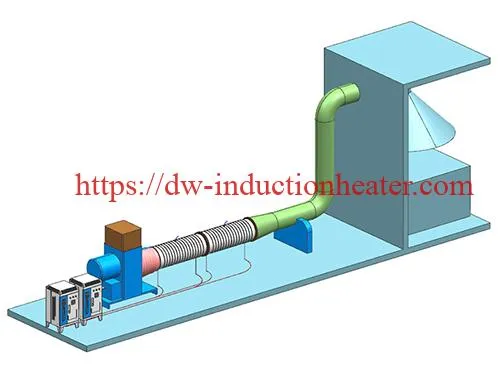
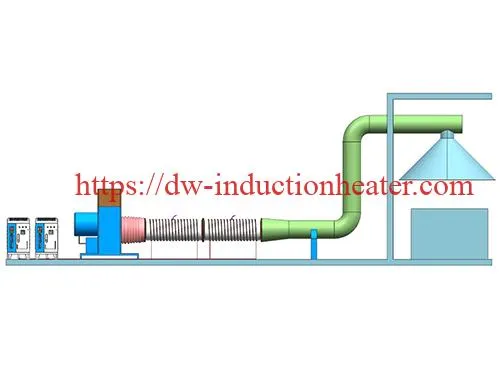
4. Induction installation are sustainable and have small carbon footprit
Nowadays the term
“sustainability” is used to talk about everything, but it hasn’t really been defined very well. Rosen, Marc & Dincer, Ibrahim made a research about exergy efficiency and sustainability, in terms of several measures (order destruction and chaos creation, or resource degradation, or waste exergy emissions). They conclude that the process can be
” sustainable” if is
energy and exergy efficient. In these terms we can said that work with induction
decrease the associated environmental impact, because gives rise to better energetic and exergetic performance.
Knowing this, the food and beverage manufacturers that will works with induction have a significant opportunity to have
“added value “ and sustainable products, working with a
clean technology which will help in protecting the environment and
decrease the carbon footprint of the food industry.
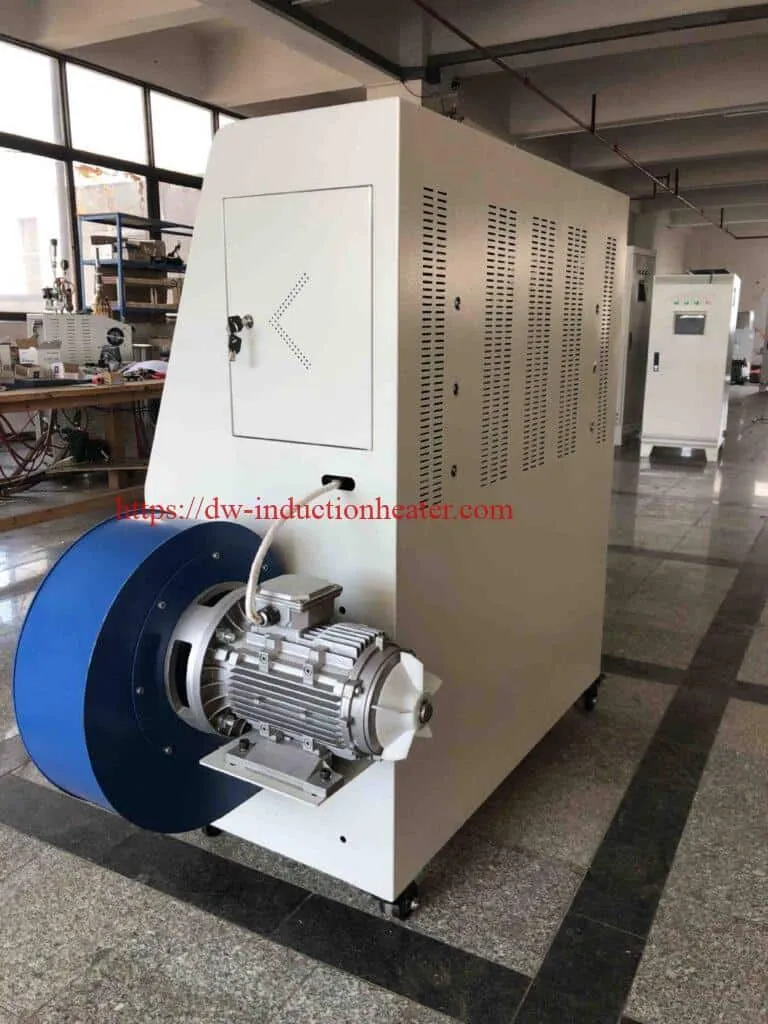
5. Induction installations improves working conditions for the employees
An induction system improves working conditions for the employees by
eliminating smoke, waste heat, noxious emissions, and
loud noise in the facilities (
Induction only heats the material and not the workshop). Heating is
safe and efficient with
no open flame to endanger the operator; non-conductive materials are not affected and can be located close to the heating zone without damage.
There are
no high pressure and
no hot steam systems and so on can avoid any hazard with
explosions like in 2016 in a dairy company in steam generator. (
In the ARIA database you will find more than 300 high temperature-related events that have occurred in France.)
Conclusion
Induction heating is a clean technological innovation designed to save energy, leading to high productivity and efficiency. Induction heating offers repeatable quality and rapid, high intensity, contact less heat generation directly, and accurate on the surface of the work-piece.
Inside the design of induction heating in a process, there is a specialized integration of workers including mechanical, electrical, and chemical engineers that will ensure a customized solution with a unique and innovative procedure with a high level of reliability and durability.
Consumers in all the world are prepared for the food business to be significantly more sustainable so we encore you to think in apply Induction heating for your company to fulfil the challenge to move towards a decrease in the footprint of the food industry, focus on the 2030 Agenda for Sustainable Development.
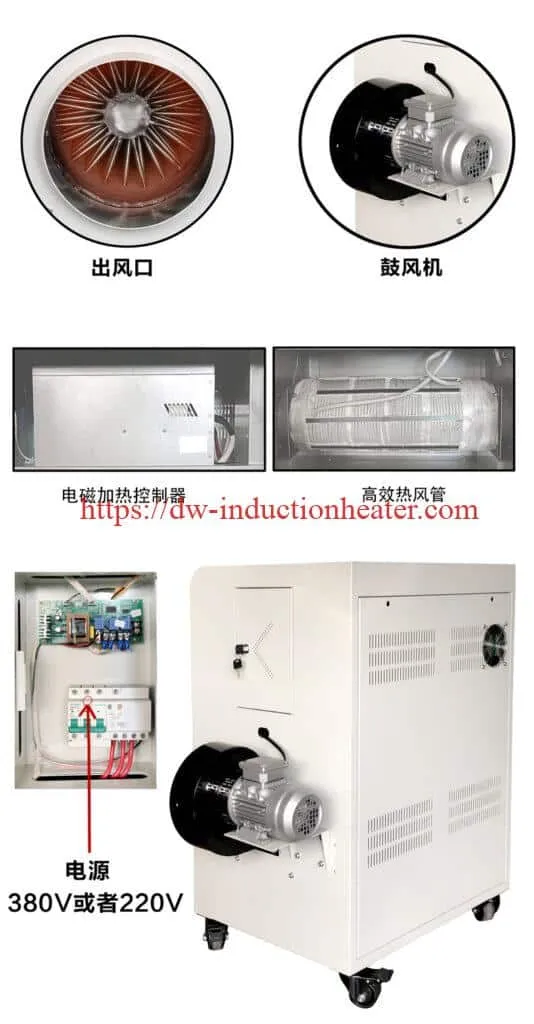 induction heating industry applications
Induction Heating Hot Air Generator
induction heating industry applications
Induction Heating Hot Air Generator
 Induction heating is an innovative and non-contact electromagnetic heating technology that has several advantages such as high energy efficiency, controlled heating, high safety, and pollution-free. The objective of this article is to build up these and other advantages based on different scientific data about the performance of induction heating in the food industry. We believe that the companies that will apply induction heating in their procedures will have more versatility in sustainable food methods and will be able to face future challenges.
Induction heating is an innovative and non-contact electromagnetic heating technology that has several advantages such as high energy efficiency, controlled heating, high safety, and pollution-free. The objective of this article is to build up these and other advantages based on different scientific data about the performance of induction heating in the food industry. We believe that the companies that will apply induction heating in their procedures will have more versatility in sustainable food methods and will be able to face future challenges.
 Induction heating has its advantages over the conventional heating systems (resistance, hot water, gas, steam, etc.) Since it is non-contact it is very efficient, and the heat is generated inside the work-piece (sample) this means direct heating of metal surface without thermal inertia and no conduction loss. And since induction requires no warm-up or cool-down cycle, make it highly compatible with energy-efficient automated systems. Read the complete article to find out the 5 most important facts about Induction Heating in the food industry.
Induction heating has its advantages over the conventional heating systems (resistance, hot water, gas, steam, etc.) Since it is non-contact it is very efficient, and the heat is generated inside the work-piece (sample) this means direct heating of metal surface without thermal inertia and no conduction loss. And since induction requires no warm-up or cool-down cycle, make it highly compatible with energy-efficient automated systems. Read the complete article to find out the 5 most important facts about Induction Heating in the food industry.




 induction heating industry applications
Induction Heating Hot Air Generator
induction heating industry applications
Induction Heating Hot Air Generator
